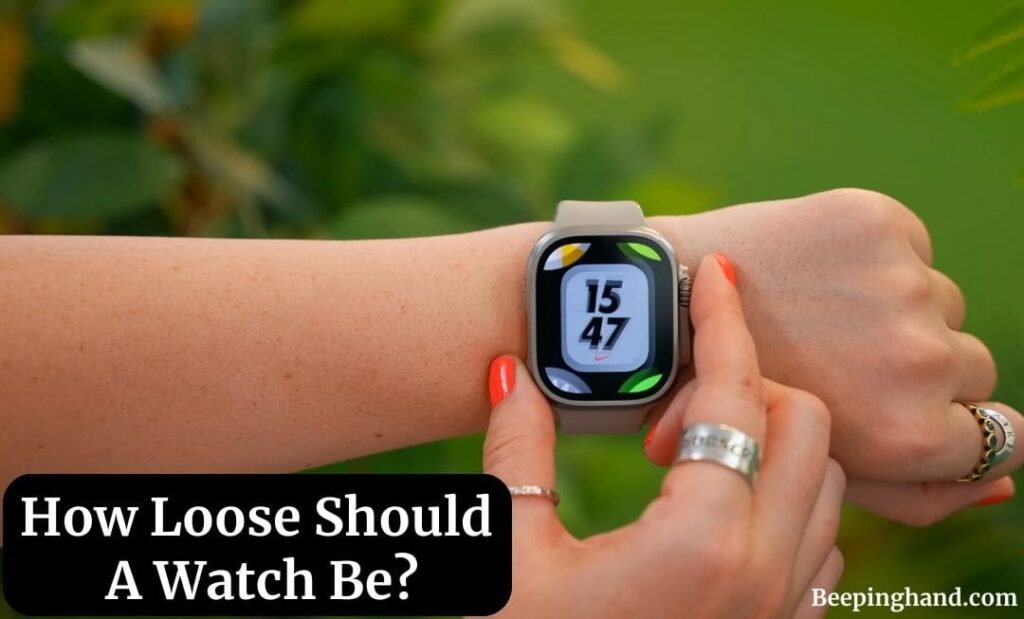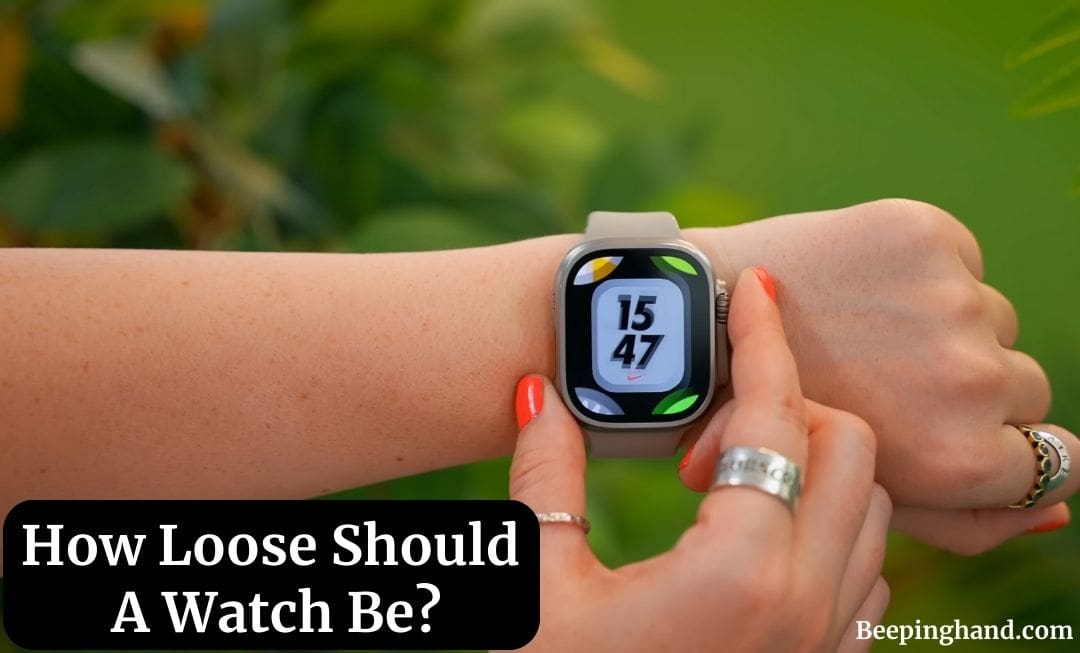A watch is more than just a timepiece, is a statement piece, an extension of your personality and style. But for it to truly shine, it needs to fit perfectly. A watch that’s too loose will flop around, causing discomfort and potentially slipping off.
Conversely, a watch that’s too tight will constrict your wrist, causing pain and irritation. Here, we’ve discussed How Loose Should A Watch Be? So, keep reading this article to deep dive into the world of watch fit and find the sweet spot between comfort and style.
How Loose Should A Watch Be

If you are interested in knowing about how loose or tight watch should a watch be on your wrist then you have come to the right place. Here, we’ve shared a detailed guide.
Consequences of a Watch Being Too Tight
- Discomfort and Pain – A watch that’s too tight can dig into your skin, causing discomfort and pain, especially during prolonged wear. This can be particularly problematic for people with sensitive skin or conditions like carpal tunnel syndrome.
- Skin Irritation – Constant pressure and friction from a tight watch strap can lead to skin irritation, redness, and even allergic reactions.
- Impaired Wrist Mobility – A tightly fastened watch can restrict your wrist’s natural range of motion, making it difficult to perform everyday tasks comfortably.
- Damage to the Watch – Excessive pressure from a tight strap can damage the watch case, clasp, and other components, leading to costly repairs.
Consequences of a Watch Being Too Loose
- Flopping Around and Inconvenience – A loose watch can flop around your wrist, causing distractions and interfering with your activities. It can also get entangled with your clothing or other objects, leading to frustration and potential damage.
- Increased Risk of Loss or Damage – A loose watch is more likely to slip off your wrist, putting it at risk of getting lost, stolen, or damaged.
- Difficulty Reading the Time – A watch that constantly moves around can be difficult to read, especially when you’re in a hurry or need to check the time quickly.
- Unprofessional or Sloppy Appearance – A loose watch can give off an unprofessional or sloppy appearance, which may not be ideal for certain occasions.
Finding the Perfect Fit: Practical Tips and Tricks
Now that we understand the importance of a proper watch fit, let’s explore some practical ways to achieve it –
The “Pinky Finger Test”
This simple test involves slipping your pinky finger between the watch strap and your wrist. Ideally, there should be enough space for your finger to fit snugly without feeling constricted. If your finger slides in too easily, the watch is too loose; if it feels crammed, it’s too tight.
The “One-Finger Rule”
Another helpful rule is to place the watch on your wrist and insert one finger beneath the strap. If you can move your finger around freely, the fit is good. However, if you can’t move your finger at all, the watch is too tight.
Taking Wrist Size and Activity Level into Account
The ideal fit will also depend on your wrist size and activity level. For smaller wrists, a slightly looser fit might be more comfortable, while larger wrists may require a slightly tighter fit for better stability. Additionally, if you engage in sports or other active pursuits, you might need a snugger fit to prevent the watch from moving around too much.
Materials and Design: How They Influence Fit
The type of watch strap material and the design of the watch itself can also impact fit. Let’s explore some specific examples –
The Impact of Watch Strap Material –
- Leather Straps – Leather is a comfortable and breathable material, but it can stretch over time, requiring adjustments.
- Metal Bracelets – Metal bracelets are durable and stylish, but they can be cold and heavy, and the links may need to be adjusted for a perfect fit.
- Fabric and Rubber Straps – These materials offer flexibility and comfort, but they may not be as durable as leather or metal.
The Influence of Watch Design –
- Case Size and Shape – A larger case may require a tighter fit for stability, while a smaller case can be worn slightly looser. The case shape can also affect fit, with curved lugs offering a more comfortable fit than straight lugs.
- Lug Design and Placement – The position and angle of the lugs can affect how the watch sits on the wrist and whether it feels bulky or comfortable.
- Clasp and Buckle Type – A clasp or buckle that is easy to adjust and secure will contribute to a better fit.
Maintaining a Good Fit: Tips and Long-Term Care
To maintain a good fit and prolong the life of your watch, consider these tips –
Regular Inspection and Adjustment
- Checking for Wear and Tear – Regularly inspect your watch strap and clasp for any signs of wear and tear. Worn-out straps can lose their elasticity and stretch, affecting the fit.
- Adjusting the Watch for Seasonality and Weight Fluctuations – Your wrist size might fluctuate slightly throughout the year due to temperature changes or weight fluctuations. Make minor adjustments to the watch strap as needed to maintain a comfortable fit.
Cleaning and Maintenance of the Watch Strap
- Proper Cleaning Techniques for Different Materials – Different strap materials require different cleaning techniques. For leather straps, use a damp cloth and a mild soap solution. For metal bracelets, use a soft brush and a non-abrasive cleaning solution.
- Preventing Discoloration and Damage – Avoid exposing your watch strap to harsh chemicals, excessive sunlight, and extreme temperatures. These can lead to discoloration, cracking, and other damage.
Cleaning and Maintenance of the Watch Strap
- Proper Cleaning Techniques for Different Materials – Different strap materials require different cleaning techniques. For leather straps, use a damp cloth and a mild soap solution. For metal bracelets, use a soft brush and a non-abrasive cleaning solution.
- Preventing Discoloration and Damage – Avoid exposing your watch strap to harsh chemicals, excessive sunlight, and extreme temperatures. These can lead to discoloration, cracking, and other damage.
Investing in Quality Watch Straps
- The Benefits of High-Quality Materials and Craftsmanship – Investing in high-quality watch straps made from premium materials like leather, alligator skin, or exotic hides can significantly improve the fit, comfort, and overall look of your watch.
- Choosing the Right Strap for Your Watch and Style – Consider the style of your watch and your personal preferences when choosing a new strap. A leather strap can add a touch of elegance, while a rubber strap can be more practical for sports and activewear.
Wrapping Up
This article is all about How Loose Should A Watch Be. Finding the perfect fit for your watch is a delicate balance between comfort and style. Experiment, explore different options, and find what works best for you. Remember, a well-fitting watch is a joy to wear and will enhance your style.
I hope this article was helpful to you and if you still find any queries then you may ask in the comment box. For more information visit the Help and Support Page.
FAQ’s How Loose Should A Watch Be
How often should I adjust my watch strap?
The frequency of adjustments depends on several factors, including the material of the strap, your activity level, and any changes in your wrist size. As a general rule, check the fit of your watch strap once a week and make adjustments as needed.
Can I wear my watch loose while sleeping?
Wearing a loose watch while sleeping can cause discomfort and potentially damage the watch. It is generally recommended to remove your watch before bed.
What type of watch strap is best for hot weather?
For hot weather, consider breathable materials like fabric or rubber. These straps will allow your skin to breathe and prevent sweating under the watch.
How can I prevent my watch from slipping off my wrist?
For a more secure fit, look for watch straps with double-prong clasps or deployant clasps.
